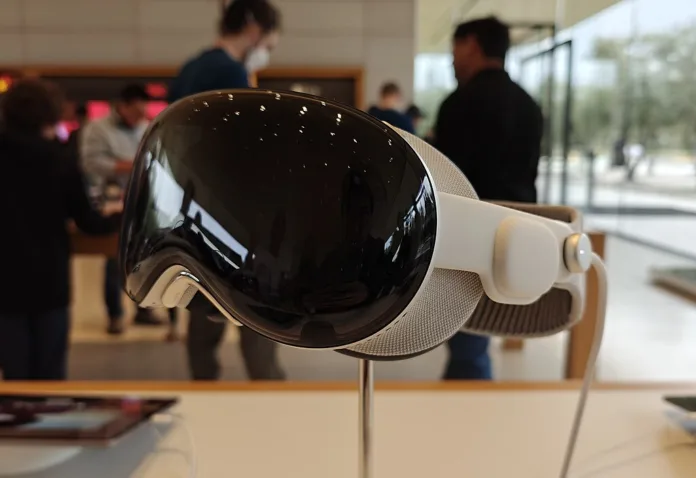Director Edward Berger’s Submerged delivers a tense WWII submarine experience in the Apple Pro immersive film on the $3,499 Vision Pro headset
For 17 gripping minutes, Submerged immerses viewers in the claustrophobic world of a WWII submarine, marking the first scripted film for Apple’s Vision Pro mixed reality headset. Directed by Academy Award winner Edward Berger, this Apple Pro immersive film showcases the transformative potential of Apple’s $3,499 headset, pushing the boundaries of 3D entertainment.
Submerged is more than just a tech demo; it’s a visually striking, carefully crafted experience that showcases what Apple’s Vision Pro can deliver. The film places its audience inside the submarine, surrounding them with 180-degree 3D visuals that feel polished and vividly immersive—one of the most compelling examples of this format to date.
Set almost entirely within the cramped, metal corridors of a submarine, Submerged follows a small group of actors as they endure the relentless tension of life beneath the waves. The close quarters and absence of rapid cuts make the submarine itself feel like another character, heightening the sense of confinement and dread. This slow, deliberate pacing gives the audience time to take in every detail of the environment, enhancing the immersive experience.
Embed from Getty ImagesThe use of 180-degree video distinguishes Submerged from earlier VR films, which often relied on 360-degree formats. While 360-degree videos allowed viewers to look around in all directions, they could feel overwhelming or disorienting. In contrast, 180-degree video mimics a stage-like setup, letting viewers focus on the action while still being able to glance around the edges, offering a more controlled but still immersive experience. This format feels more refined and suited to narrative-driven content, making Submerged feel like an interactive stage play unfolding in real time.
For director Edward Berger, known for his Academy Award-winning work on All Quiet on the Western Front (2023), the jump into immersive video was entirely new. “I was completely innocent to this technology,” Berger told CNET. “I’d never done stereoscopic photography before.” His previous lack of experience in virtual reality (VR) formats made him approach the project with fresh eyes, focusing on how tension could be heightened using this new medium.
Berger and his team drew inspiration from their initial experiences with the Vision Pro, exploring how the immersive qualities of the headset made viewers feel during documentaries and music performances. They quickly realised that a confined setting, like a submarine, would amplify the tension and make the experience feel more visceral. This led them to experiment with different filming techniques like camera shakes and how quickly the immersive camera could move through tight hallways without breaking the sense of reality.
Filming in this format presented unique challenges. The large 3D camera used to capture the scenes had to be carefully managed to avoid being seen in the 180-degree shots. The production team employed specialised cranes and other equipment to achieve the desired effects, making it a technical as well as a creative achievement.
Apple’s push into scripted VR films isn’t entirely new territory for the tech world. Companies like Meta, Google, and Samsung have previously dabbled in immersive content, funding creative projects and experimenting with various video formats. However, the level of production quality in Submerged—from its set construction to its unique filming techniques—shows how much more refined Apple’s approach has become.
The film’s success also lies in its ability to immerse viewers in a highly detailed world without overwhelming them. The Vision Pro headset’s technology allows for crisp, vibrant visuals that give the impression of being physically present within the submarine. Every rivet on the walls and every bead of sweat on the actors’ faces add to the authenticity, pulling viewers deeper into the story.
As Apple looks to position the Vision Pro as more than just a high-end tech gadget, content like Submerged could play a pivotal role in convincing consumers of its potential. The mixed-reality headset, which blends virtual and real-world elements, has been marketed as a versatile tool for work, entertainment, and communication. But it’s immersive films like Submerged that may ultimately demonstrate how transformative this technology can be.
For now, Apple has positioned Submerged as a flagship experience for the Vision Pro, giving users a taste of what high-end VR filmmaking could look like. With a price tag of $3,499, the Vision Pro is clearly aimed at early adopters and those eager to experience cutting-edge mixed-reality content. If Submerged is any indication, the future of entertainment could very well lie in experiences that blur the line between the viewer and the story, offering an entirely new way to engage with narratives.
Edward Berger’s dive into VR filmmaking may have started with innocence, but with Submerged, he’s crafted a sophisticated, immersive experience that hints at the future of storytelling in the digital age.
